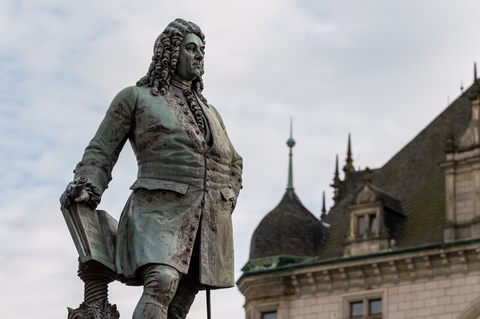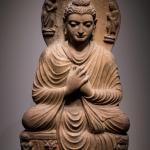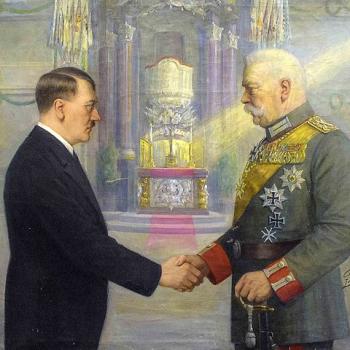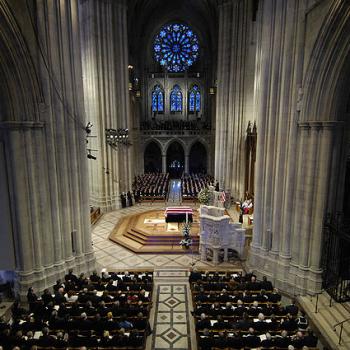There are a number of dubious stories about George Frideric Handel’s oratorio Messiah. (The formal name of the piece is Messiah, not The Messiah.) For example, Handel is said to have composed the very long work in a remarkably short time. I’ve seen claims that he composed it all in nine days, although other estimates say it was twenty-four days, or maybe three to four weeks. Four weeks is still remarkable. Handel’s Messiah is a lot of music. A standard vocal score — just the voice parts, not the orchestra — has more than 250 pages of music. I doubt one person could copy the thing in just nine days, never mind compose it.
The alleged speed at which Handel wrote all this music gave rise to legends that he worked in a state of inspired spiritual ecstasy. As he composed the iconic Hallelujah Chorus he beheld a vision of heaven opening up before him, it is said. It has also been speculated that Handel was bipolar and wrote his best music during manic phases. And music historians point out he wrote most of his compositions, including non-sacred works, with similar speed.
About G. F. Handel
George Frideric Handel (1685-1759) was born in Halle, Germany, and he studied music and worked as a conductor and composer in Germany and Italy before moving to London in 1712. He became a naturalized British subject and has been embraced as a British composer. Among his early British works were four anthems commissioned for the coronation of King George I in 1714. One of these, Zadok the Priest, has been played at the coronation of every British monarch since.
Unlike most other composers of his time, Handel depended less on commissions and patronage and more on composing for the theater and concert hall. He was as much a showman as he was a composer. He had early success with several Italian operas that were performed at either the King’s Theatre (today His Majesty’s Theatre) or the Covent Garden Theatre in London. Handel’s Covent Garden opera company was especially known for spectacular productions.
But in the late 1730s competition from a rival opera company combined with a loss of interest in Italian opera changed Handel’s fortunes. His last opera, Deidamia, based on a story from Greek mythology, closed after three performances in January 1741.
From Opera to Oratorio
By 1741 Handel had lost a great deal of money. His operas required costumes and staging and soloists imported from Italy. He needed to fill the house for many performances to make a profit. When that stopped happening, Handel turned his attention to another musical form, oratorio.
An oratorio also tells a story, usually but not always based on something from the Bible. The soloists sometimes — but not in Messiah — sing specific roles as they would in an opera. But the singers can be stationary and require no costumes, props, or stage sets. And English oratorios could be sung by English singers, not imported Italian divas.
Messiah was not Handel’s first oratorio. His earlier oratorios include Alexander’s Feast (1736), Saul (1739), and Israel in Egypt (1739). The composition of Israel in Egypt, which tells the story of Moses and the Exodus, shows Handel learning to adapt English oratorio to his audiences. The first performance, at the King’s Theatre, was greeted with a resounding meh. So he revised the work, adding flashy solos and cutting back choruses to give the ticket buyers more of what they wanted. Israel in Egypt is a great oratorio, by the way.
The Dublin Debut of Handel’s Messiah
However long it took, Handel’s Messiah was composed in 1741 with a text compiled mostly from the King James Bible by Charles Jennen. The oratorio was first performed at the Dublin Musick Hall on April 13th, 1742, to a sold-out crowd. To squeeze more people into the theater, the theater owners asked gentlemen patrons to leave their swords at home, and the ladies were requested to not wear overly full skirts.
The first performance featured a small orchestra and a 32-voice chorus of men and boys, recruited from the choirs of two Dublin cathedrals, St. Patrick’s and Christ Church. Irish clergy objected to the use of cathedral choirs for a money-making venture, and so profits from the Dublin performances were donated to charity. Male solos were assigned to chorus members. The women soloists were the soprano Christina Maria Avoglio and the contralto Susannah Cibber.
Cibber was a well-known stage actress who was going through a scandalous divorce at the time, and it’s possible her notoriety helped ticket sales. It’s recorded that at the debut performance, when Cibber finished the aria “He Was Despised and Rejected of Men,” a clergyman identified as the Rev. Delaney leapt to his feet and exclaimed, “Woman, for this be all thy sins forgiven thee!”
Controversy at the London Premier
Protests erupted before the first London performance at Covent Garden on March 23, 1743. The subject matter was too sacred to perform in a theater and not a church, people said. Handel tried to tamp down the objections by advertising the work as a “New Sacred Oratorio,” avoiding the title Messiah. Six performances were planned, but only three were performed. The oratorio was performed twice in 1745 and not again until 1749. But then London audiences got over their objections. Messiah became Handel’s most popular composition during his lifetime, and ever since.
There is a legend that King George II attended the London premier and stood during the Hallelujah Chorus, causing the audience to stand also. And, ever after, audiences have stood for the Hallelujah. There is no record that the King was in the audience, however, and the first extant mention of the audience standing for the Hallelujah happened several years later. So no one knows how that tradition started. (Let me add that I’ve sung in a few dozen Messiah choruses, and I love it when the audience stands. It’s an appropriate tribute to Handel and the single most popular chorus in the entire choral repertoire.)
The music performed in London was not identical to that performed the year before in Dublin. Handel may have written the first draft of Messiah with remarkable speed, but he spent the rest of his life fiddling with it. Bits of music were added and subtracted. Arias were rewritten to fit the range of the soloist. Or the aria might be turned into a chorus. There isn’t any one “final” version.
About Handel’s Messiah
A complete Messiah is in three parts. Part One is the Christmas section, beginning with Old Testament prophecies to the birth of Jesus. Part Two depicts Christ’s passion and death to the moment of Resurrection, which is expressed in the Hallelujah. Part Three expresses the promise of redemption and eternal life, ending with the glorious Amen Chorus.
I’ve already mentioned that Messiah is a long work. Performing the entire piece can take anywhere from two to five hours, depending on tempos. (Some of you may be skeptical that a complete Messiah can be performed in two hours, but I have been in choruses that did it.) The vocal music is not especially difficult, and any halfway decent community chorus can probably handle it with enough rehearsing. The hardest part for most choristers are the running notes, patterns of 16th notes that should be sung crisply and cleanly but tend to turn into mush. For an example of what the running 16th notes should sound like, check out this video of the chorus “For Unto Us a Child Is Born” and pay attention to the soprano line after about the .30 mark.
Handel intended the piece to be performed at Easter time, not Christmas. For Christmas time it’s common to just perform Part One and then end with the Hallelujah, which is at the end of Part Two. If you ever go to a performance of the complete work, remember that it isn’t over at the Hallelujah. There’s still a lot of music left. So don’t bolt out of the auditorium at the end of the Hallelujah to get to your car and beat the traffic. I’ve seen people do that many times.
About Baroque Music
Baroque refers to a style of art, architecture, dance, music, and many other things that flourished in Europe from about 1600 to the 1750s. Baroque is known for intricate ornamentation, movement, brightness, exuberance. I understand that Baroque audiences were more keen on the soloists than the choruses. And the soloists were expected to improvise their own embellishments to the score. Along with adding trills and grace notes not written by the composer, it was not unheard of for a soloist to add several measures of vocal fireworks not written in the score to show off for the audience.
When that happened, the basso continuo — also improvised — was expected to keep going also. In Baroque compositions the basso continuo is the foundation or “spine” of the piece, played on harpsichord or organ, cello, lute, or theorbo. The continuo musicians improvised a running pattern of notes from the bass line in the score. This is not unlike the role of the double bass player in jazz.
One other strange but true feature of Baroque music were the castrati. A castrato was a male singer who had been castrated before puberty to preserve his high range. Yes, this really happened. This is an ancient practice that became common in 17th and 18th century Europe. Castrati sang the women’s voice parts in cathedral choirs. Many lead roles in Baroque opera were written for castrati. Some castrati were big stars, with amazing voices that drew big audiences. Handel often employed castrati in his operas and other productions. A soprano castrato named Gaetano Guadagni is known to have sung solos in Messiah under Handel’s direction. Castrati went out of style in the 19th century, and the barbaric practice was finally stopped. The last castrato singer for the Sistine Chapel choir died in 1922. Today opera roles written for castrati are sung by women or countertenors.
Handel’s Messiah After Handel
Handel died in 1759 at the age of 74. Just a few days earlier he had made his last public appearance at a performance of Messiah. Handel was given a state funeral and is buried in Westminster Abbey.
In the 19th century performances of Handel’s Messiah got bigger and grander. Huge choruses were assembled to sing it, and orchestras grew likewise. It became a slow and ponderous work. The driving movement and dazzle of Baroque were buried under the overstuffed fussiness of Victoriana. In recent decades many music directors have pared down the choruses and orchestras to be closer to what the piece sounded like in Handel’s time. You can keep your 500-voice choruses, thanks much.
Today there is also the question of which version of Handel’s Messiah to perform. There are occasional attempts to re-create a particular performance from Handel’s notations. Or, the music director may pick and choose from among several versions. This review from Gramophone magazine discusses what’s right, and wrong, about several recordings. And if you do get a chance to attend a live performance, please do so and enjoy. Remember to stand for the Hallelujah.














